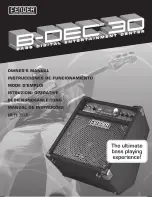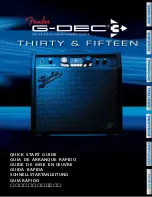
PC-505B Manual, Rev. 201013
Warner
Instruments
A Harvard Apparatus Company
37
THEORETICAL CONSIDERATIONS
Chloriding silver wire
Silver-silver chloride electrodes act as signal transducers by converting ionic currents in
solution to an electric current within a wire. This is achieved by utilizing a reversible
oxidation/reduction reaction between the electrode and Cl
-
ions in solution. The chemical
reaction is:
Cl
-
+ Ag
AgCl + e
-
The potential developed by one electrode is proportional to the standard electrochemical
potential for Ag/AgCl plus the Cl
-
concentration at the solution/electrode interface. Since this
potential is dependent on Cl
-
, a voltage bias will be introduced by changing the solution Cl
-
concentration. Therefore, we recommend that Ag/AgCl electrodes be connected to the bath
through agar salt bridges to maintain a constant Cl
-
concentration near the electrode. In addition,
the isolation provided by the agar bridge will prevent Ag
+
ions from contaminating the baths.
First clean the wire by wiping with a clean tissue wet with alcohol or a standard laboratory
detergent, then rinse well with distilled water. Wiping in this way can help to straighten the wire.
If using alcohol or similar solvent, avoid getting it onto the polycarbonate holder body as this can
weaken the structure.
Chloriding by electrolysis
Dip the Ag wire to the required depth in a solution of 0.1M NaCl or KCl, optionally made
slightly acidic with HCl, and arrange to pass positive current from the Ag into the solution.
For the indifferent electrode in the solution, a cleaned carbon rod from a discarded 6 V
lantern battery works well. Another, thicker, Ag wire will also work, but most other metals
are likely to contaminate the AgCl coat. Pass current at a density of about 1 mA/cm
2
for
about 1 minute or until adequately plated. For a 2 cm length of 0.01" wire, this is about 150
µA. When well plated, the surface should be uniformly light grey.
Reversing the current polarity occasionally while plating, ending with the Ag positive, tends
to make a more stable electrode. If available, a low-frequency signal generator at about 0.1
Hz, with a slight positive bias is also convenient. The electrolyte solution can be saved and
reused indefinitely.
Chloriding chemically
Immerse the clean Ag wire in Clorox solution until the wire is uniformly light gray, about
1-10 min. Rinse well with tap water, then with distilled.
Electrode holders
The standard holder used with
PC-505B
are the
QSW-AxxP
straight body style (purchased
separately). These holders use a 0.010" diameter, 99.99% pure silver wire to couple the signal
from the micropipet solution to the input pin of the headstage amplifier. Before use, the electrode















































